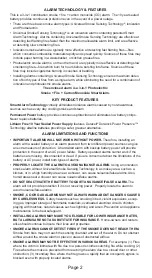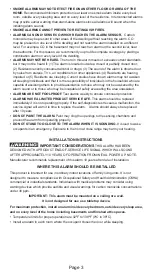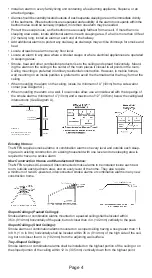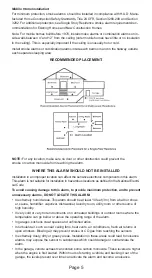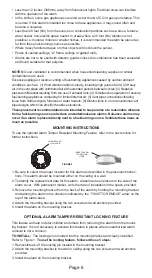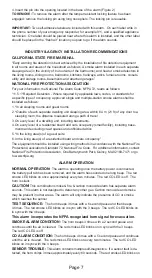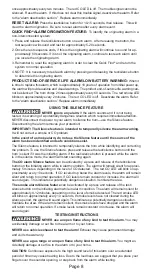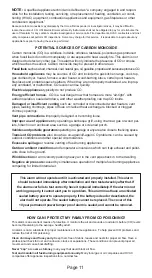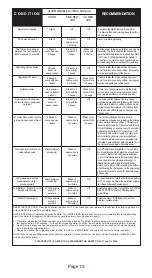
Page 3
• SMOKE ALARMS MAY NOT DETECT FIRE ON ANOTHER FLOOR OR AREA OF THE
HOME.
Recommended minimum protection is at least one smoke alarm inside every bed-
room, outside every sleeping area and on every level of the residence . Interconnected alarms
may provide earlier warning than stand-alone alarms since all alarms will sound when the
initiating alarm sounds .
• SMOKE ALARMS CANNOT PREVENT OR EXTINGUISH FIRES.
• ALARMS CAN ONLY SENSE CO WHICH REACHES THE ALARM SENSOR.
Carbon
monoxide may be present in other areas of the dwelling without reaching the alarm . CO
may be present on one level of the dwelling and not reach the alarm installed on a different
level . For example, CO in the basement may not reach an alarm on the second level, near
the bedrooms . For this reason, we recommend you provide complete coverage by placing a
combination alarm on every level of the dwelling .
• ALARMS MAY NOT BE HEARD.
The horn in this alarm meets or exceeds current standards,
but it may not be heard if: (1) The alarm is located outside a closed or partially closed door;
(2) Residents recently consumed alcohol or drugs; (3) The sound of the alarm is drowned out
by noise from stereos, TV’s, air conditioners or other appliances; (4) Residents are hearing
impaired or (5) Residents are sleeping. Current studies have shown alarms may not awaken
all sleeping individuals and that it is the responsibility of individuals in the household who are
capable of assisting others to provide assistance to those who may not be awakened by the
alarm sound or to those who may be incapable of safely evacuating the area unassisted .
• ALARMS ARE NOT FOOLPROOF.
Test alarms weekly to ensure continued protection .
• ALARMS HAVE A LIMITED PRODUCT SERVICE LIFE.
This alarm should be replaced
immediately if it is not operating properly . If the self-diagnostic test reveals a malfunction, the
service signal will warn it is time to replace the alarm . Alarms should always be replaced
after 10 years .
• DO NOT PAINT THE ALARM.
Paint may clog the openings to the sensing chambers and
prevent the alarm from operating properly .
• DO NOT STAND TOO CLOSE TO THE ALARM WHEN IT IS SOUNDING.
It is loud to wake
occupants in an emergency . Exposure to the horn at close range may harm your hearing .
INSTALLATION INSTRUCTIONS
IMPORTANT CONSIDERATIONS
THIS ALARM HAS BEEN
DESIGNED WITH A PRODUCT END-OF-SERVICE LIFE SIGNAL WHICH WILL SOUND
AFTER APPROXIMATELY
10 YEARS OF OPERATION FROM INITIAL POWER UP . NOTE:
Manufacturer recommends replacement of this alarm 10 years after date of installation .
WHERE THIS ALARM SHOULD BE INSTALLED
This product is intended for use in ordinary indoor locations of family living units . It is not
designed to measure compliance with Occupational Safety and Health Administration (OSHA)
commercial or industrial standards . Individuals with medical problems may consider using
warning devices which provide audible and visual warnings for carbon monoxide concentrations
under 30 ppm .
IMPORTANT: This alarm must be mounted on a ceiling or a wall.
It is not designed for use as a tabletop device.
For maximum protection, install an alarm inside every bedroom, outside every sleep area,
and on every level of the home including basements and finished attic spaces.
• Temperature limits for proper operation are 32ºF to 100ºF (0ºC to 38ºC).
• Install an alarm in each room where the occupant closes the door while sleeping .
Содержание MPC322S
Страница 14: ...Page 14...


